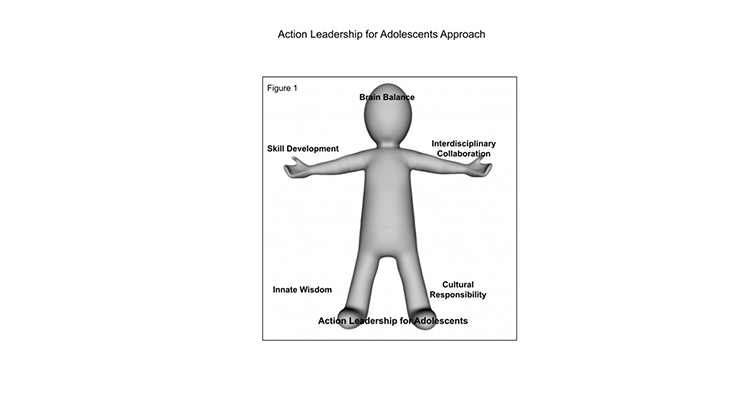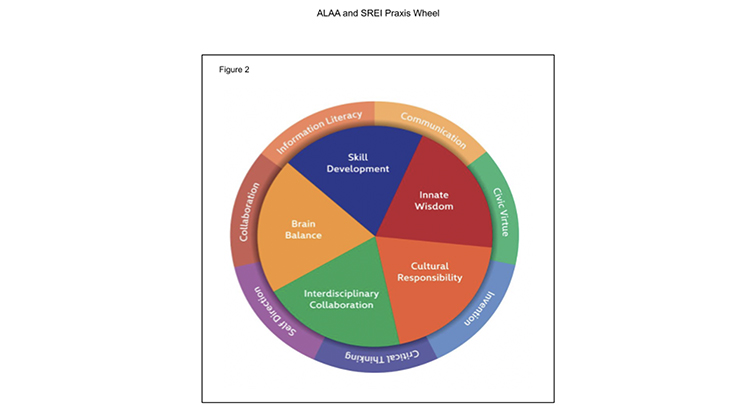Transforming Adolescent Engagement: The Action Leadership Approach to Education

Action Leadership for Adolescents (ALAA) is a multi-pronged innovative approach where educators can forgo a one-size-fits-all teaching strategy. It is a pedagogical approach that addresses the ever-changing need to have strategies that recognize individuals and support the evolution of a collective community. While there are many challenges educators face around the globe, the focus of this article is on how to increase engagement, retention, and literacy through layering principles of ALAA into the planning and preparation for any type of programming for adolescents. ALAA effectively addresses challenges of engagement, matriculation, and skill development by fostering leadership skills, increasing autonomy, and promoting a proactive, collaborative learning environment. With its founding in Youth Participatory Action and the Positive Youth Development models, ALAA focuses on five principles to bolster youth development, which are measured through a Self-Reflection Evaluation Inventory (Hamdorf, 2013). Research in out-of-school time and traditional classroom studies has been conducted to demonstrate how to use the approach and measure student growth.
Foundation of ALAA
Action Leadership for Adolescents Approach (ALAA) is supported by several foundational models emphasizing youth development, leadership, and interdisciplinary learning. ALAA draws from Youth Participatory Action Research (YPAR). This method empowers adolescents to participate in community decision-making and problem-solving through an iterative approach where problems are examined, solved, analyzed, reflected upon, and then examined again - a spiral model. YPAR also highlights the importance of including adolescents in leadership roles where they are active agents of change rather than passive recipients of instruction. It is a cyclical and organic process that inherently promotes reflection of actions taken. The implementation of the model requires real-world synthesis and application. YPR allows educators and facilitators to explore the pressing challenges confronting historically marginalized youth, advocating for a more critical and participatory approach to youth development involving young people in investigating and addressing the social issues affecting their lives (Rodriguez and Brown, 2009). Three guiding principles have proven effective in leveraging participatory action research for social and educational transformation. Those guiding principles are: inquiry-based, participatory, and transformative (Anyon, Kennedy, Durbahn, Jenson, 2018).
Building on the foundation of Youth Participatory Action Research (YPAR), ALAA is closely aligned with the humanistic principles of Positive Youth Development (PYD). It leverages PYD's core values to promote holistic growth and well-being in youth, emphasizing their capacity for autonomy, personal development, and meaningful contributions to their communities. PYD encourages stakeholders and community members to accept the positive perspective of human nature, where adolescents can take charge of their lives, making independent decisions to pursue happiness, fulfillment, and personal growth (Brown, 2011).
It is valuable to identify three additional models and approaches that also fall under the PYD model and are commonly used worldwide. The first is Benson’s 40 Development Assets, whereby the 40 Developmental Assets are essential building blocks that support positive youth development, categorized into external and internal assets. (Benson, 1997). The second contribution under PYD, Lerner’s 5Cs model, outlines five key qualities that help adolescents thrive: Competence, Confidence, Character, Connection, and Caring. When these five Cs are nurtured, they lead to a sixth C - Contribution, where youth give back to their communities and society. A third contribution to ALAA, and also falling under the PYD umbrella, is Catalano’s Framework, which encourages resilience, strong relationships, positive values, and planning for the future. The framework highlights the importance of strong relationships, social and emotional skills, self-confidence, and purpose, as well as the role of positive values and future aspirations in shaping well-rounded individuals. (Catalano, 2004)
ALAA advances PYD and YPAR through its five principles, fostering transformation and growth. These foundational theories help ALAA create a responsive and adaptive framework, fostering leadership in adolescents and enhancing their engagement through active participation, interdisciplinary learning, and cultural relevance. These principles of ALAA will be reviewed in the next section.
Defining ALAA and the Five Principles
The five principles of ALAA, displayed in Figure 1, are brain balance, interdisciplinary collaboration, skill development, innate wisdom, and cultural responsibility. Educators can integrate principles into lessons by pairing them or rotating one at a time, adjusting to students' attention spans, and switching when a change of pace is needed. The principles of ALAA are briefly described below.

1 Brain Balance: Maximizing brain plasticity during adolescence requires the creation, practice, and habitual use of new neural pathways. Regular exposure to novel experiences, along with brain breaks and varied teaching methods - such as role-playing, debates, and group discussions - optimizes cognitive development by enhancing synaptic connections and increasing cognitive load.
2 Interdisciplinary Collaboration: Adolescents from different academic or interest areas work together to achieve common goals by combining their diverse perspectives, knowledge, and skills. This collaborative approach allows them to tackle complex challenges more innovatively and effectively, creating a broader, more comprehensive understanding that transcends individual disciplines or experiences.
3 Skill Development: Adolescents need explicit instruction in building academic, social, emotional, and life skills for personal growth, school success, and future challenges. Clear guidance helps them identify, develop, and measure these skills, preparing them for adulthood and enabling them to navigate future obstacles with greater competence.
4 Innate Wisdom: Adolescents’ leadership and community connections are shaped by their intuitive ability to draw on prior knowledge and experience. By activating and enhancing their cognitive load, they contribute to the learning environment through historical insights and shared wisdom, fostering a deeper connection to their communities.
5 Cultural Responsibility: Adolescents bear the responsibility of preserving and honoring cultural traditions and values, both personally and within society. This commitment fosters a socially responsible community by recognizing the importance of cultural identity, ensuring that individual and collective needs are met within a meaningful cultural context.
The placement of these principles as demonstrated in Figure 1 reflects the holistic approach of the ALAA model, emphasizing the importance of a balanced brain (aligned with Maslow's higher needs) and the integration of "we" through collaboration and cultural responsibility, and "me" through skill development and innate wisdom.
Measuring the Efficacy of ALAA
One way to measure the efficacy of ALAA is through the Self-Reflection Evaluation Inventory (SREI). The SREI is a structured tool that requires individuals to assess seven 21st Century Skills as described in Figure 2. It incorporates both quantitative and qualitative measures to provide a comprehensive evaluation. Quantitatively, the SREI employs a Likert scale, allowing learners to rate their agreement with various statements related to their learning behaviors and attitudes. Qualitatively, it asks for written reflection prompts, encouraging individuals to elaborate on their experiences, thought processes, and strategies for improvement. By encouraging individuals to reflect on their learning processes, the SREI can provide insights into a learner’s autonomy, adaptability, and readiness to engage in continuous, self-regulated learning. This makes it a valuable tool for educators and learners alike, helping to pinpoint areas for improvement to foster a growth mindset while also providing anecdotes to further develop activities that helped students practice and refine a said skill.
For a more in-depth exploration of the connection between ALAA and the competencies assessed by the SREI, refer to the paper titled, Impact Study of an Action Leadership for Adolescent Approach in Traditional Educational Settings (Hamdorf, 2024). This study provides insights into how ALAA fosters the development of key skills that are systematically measured through the SREI framework. To summarize the relationship between ALAA and the SREI, refer to Figure 2, which illustrates how all the skills measured in the SREI can be seamlessly embedded within the five core principles of ALAA. Figure 2 demonstrates how both the principles of ALAA, found in the inner circle and the skills measured in SREI, work in tandem to enhance autonomous learning and leadership in educational settings.

Impact of ALAA on Student Engagement and Retention
The ALAA framework supports student retention and matriculation by cultivating essential skills such as leadership, self-regulation, and resilience. By encouraging students to take ownership of their learning, ALAA promotes engagement, a critical factor for academic persistence. Student engagement is a condition of emotional, social, and intellectual readiness to learn, characterized by curiosity, participation, and the drive to learn more (Abla and Fraumeni, 2019). This definition underscores the multi-dimensional nature of engagement, emphasizing the importance of both intrinsic motivation and active involvement. Engagement is considered a reciprocal process that requires student effort and institutional support and is closely linked to academic achievement, retention, and matriculation outcomes.
Through its emphasis on personal growth, interdisciplinary collaboration, and cultural responsibility, ALAA enables students to connect academic knowledge with real-world challenges. By enhancing engagement, fostering a sense of belonging, and improving self-efficacy, ALAA encourages long-term commitment to education, reducing dropout rates and facilitating smoother transitions between educational stages. This comprehensive approach ensures students are better equipped to persist and succeed academically. ALAA’s emphasis on real-world problem-solving ensures skill development that is both relevant and meaningful, increasing students' investment in their education. The framework incorporates seven 21st-century skills promoting reflective practices and personal growth evaluated in the SREI.
Additionally, a sense of belonging and community is also nurtured, as students involved in leadership roles feel more connected to their school. Moreover, the development of self-efficacy through leadership activities boosts students' confidence in their ability to succeed. Finally, ALAA's personalized learning approach, allowing adolescents to have more input in their educational experience, addresses individual needs, further supporting retention and matriculation.
Findings
In the study of 12th-grade students conducted during the United States school year in 2021-2022 in which ALAA was used to guide the course of instruction, students demonstrated the most significant gains in the skill of communication, where the mode score increased from 7 to 10 between the pre- and post-surveys. Other notable improvements in skills included invention and critical thinking. The mode score for invention increased slightly from 6 to 8, with a significant rise in respondents selecting 8 (from 6% to 38%). Similarly, critical thinking saw an increase in respondents selecting a score of 8, from 26% to 48%, despite the mode score remaining the same.
Participants highlighted key experiences that facilitated the development of the aforementioned essential skills through a variety of structured activities. For communication, participants improved through meetings with adults beyond the school, interviews with career professionals, and role-playing among peers. Civic virtue was enhanced by involvement in community projects and discussions around social justice. Critical thinking was strengthened through research, debates, and project proposals. Information literacy grew from research tasks, including interviews and library lessons in scholarly research. Self-direction was promoted by goal setting and project timelines, while collaboration involved teamwork and feedback sessions. Lastly, invention was fostered through project iterations and creative design processes.
The study explored the impact of ALAA on improving 21st-century skills, as measured by the SREI. The findings highlighted significant growth in three areas: communication, information literacy, and invention. Communication saw the greatest increase, with a 3-point rise in mode score. Information literacy and invention also demonstrated growth, with mode scores increasing by 1 and 2 points, respectively. These results indicate that ALAA effectively enhances key 21st-century skills in adolescents. While each experience could be tied to a specific principle of ALAA, the value of self-reflection and growth lies in recognizing that all five principles are interconnected. Each principle serves as an access point to the others, ensuring a balanced and transformative educational experience for adolescents that focuses on strengths and holistic growth, again considering the ALAA Wheel in Figure 2 that promotes the flexibility of teaching and reflecting on any given 21st-century skill through a principle of ALAA.
Next Steps
ALAA is a transformative educational strategy that fosters student engagement, retention, and literacy by integrating leadership, active learning, and collaboration. To advance the implementation of ALAA and maximize its impact on student engagement, retention, and literacy, several steps must be taken to ensure effective integration and long-term sustainability. A priority should be providing teachers with comprehensive training and support to facilitate the principles of ALAA in their classrooms through professional development. Educators must be equipped with the knowledge and skills to implement interdisciplinary collaboration, foster leadership, and enhance student autonomy. Targeted professional development should include hands-on workshops, coaching sessions, and collaborative planning opportunities that align with ALAA’s core principles.
A phased approach to implementation, beginning with a pilot program, will allow educators to test the ALAA model in select classrooms or grade levels. This pilot phase will provide the opportunity to gather valuable data, refine lesson plans, and evaluate the effectiveness of the approach in improving student outcomes. Piloting will also create a learning loop, where insights from early adopters can be used to adjust the framework and prepare for broader implementation across schools or districts. In parallel with piloting, continuous research, and evaluation of ALAA’s effectiveness is critical. This includes using tools such as the Self-Reflection Evaluation Inventory (SREI) to measure progress in key areas like communication, critical thinking, collaboration, and leadership. Longitudinal studies that track student growth over time will provide concrete evidence of the model’s success in fostering academic engagement, skill retention, and matriculation. By collecting data, both quantitative and qualitative, educators and researchers can identify areas of improvement and enhance ALAA’s effectiveness.
By taking these strategic next steps, educators and administrators can ensure that ALAA’s innovative approach to adolescent education not only enhances student engagement and learning outcomes but also provides a scalable and sustainable framework for future success.
References
Abla, C., & Fraumeni, B. R. (2019). Student engagement: Evidence-based strategies to boost academic and social-emotional results. McREL International.
Anyon, Y., Kennedy, H., Durbahn, R., & Jenson, J. M. (2018). Youth-led participatory action research: Promoting youth voice and adult support in afterschool programs. Afterschool Matters, 27, 10-18. https://files.eric.ed.gov/fulltext/EJ1175037.pdf
Benson, PL. All Kids are Our Kids: What Communities Must Do to Raise Caring and Responsible Children and Adolescents. 2nd San Francisco, CA: Jossey-Bass; 1997. available from psycnet.apa.org/record/2006-13341-000.
Brown, BB, Prinstein MJ, eds. Encyclopedia of Adolescence. New York, NY: Elsevier; 2011. doi: 10.1016/C2009-1-03841-6
Catalano, RF. Berglund, ML, Ryan, JAM, Lonczak, HS, Hawkins JD. Positive youth development in the United States: research findings on evaluations of positive youth development programs. Ann Am Academy Political Social Science, 2004; 591 (1): 98-124. doi 10.1177/0002716203260102
Hamdorf, L. K. (2013). The impact of leadership training on the civic awareness and leadership development of Saint Croix Foundation Youth Advisory Council members (ED561722). ERIC. https://eric.ed.gov/?id=ED561722
Hamdorf, L. (2024) Impact Study of an “Action Leadership for Adolescent Approach” in Traditional Education Settings. Open Journal of Leadership, 13, 168-194. doi: 10.4236/ojl.2024.132011.
Rodríguez, L.F. and Brown, T.M. (2009), From voice to agency: Guiding principles for participatory action research with youth. New Directions for Youth Development, 2009: 19-34. https://doi.org/10.1002/yd.312
United Nations Children's Fund (UNICEF). (2017). The adolescent brain: A second window of opportunity – A compendium. UNICEF. https://reliefweb.int/report/world/adolescent-brain-second-window-opportunity-compendium
Warren, J. L., & Warren, J. S. (2023). The Case for Understanding Interdisciplinary Relationships in Health Care. Ochsner journal, 23(2), 94–97. https://doi.org/10.31486/toj.22.0111
Image by cottonbrostudio